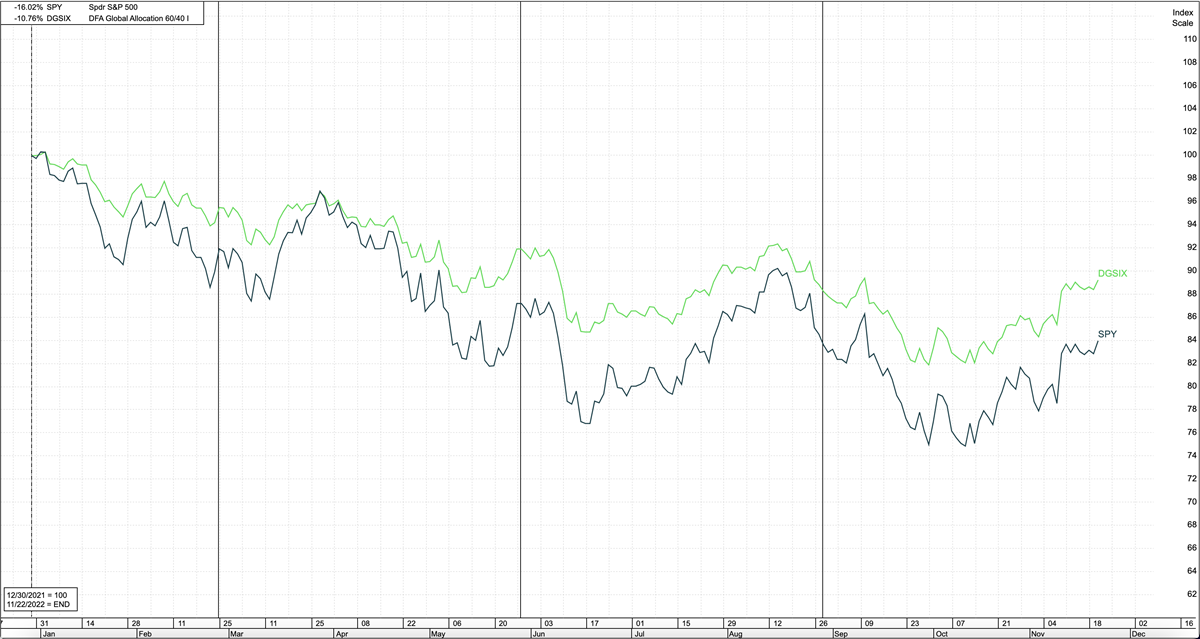Is the 60/40 Portfolio Mix Still in Vogue?The classic 60/40 portfolio, consisting of 60% stocks and 40% bonds, has served investors well. But in volatile conditions, does that mix still make sense?
ByKate StalterOriginally published
This story originally appeared onMarketBeat

The classic 60/40 portfolio, consisting of 60% stocks and 40% bonds, has served investors well over the years. A very basic 60/40 allocation, which includes international securities, might consist of theSPDR Portfolio MSCI Global Stock Market ETF(NYSEARCA: SPGM)combined with theVanguard Total International Bond ETF(NYSEARCA: BNDX).
While it's not nearly as efficient and doesn't offer true global diversification, plenty of U.S. investors achieve a 60/40 mix using theSPDR S&P 500 ETF(NYSEARCA: SPY)and theiShares Core US Aggregate Bond ETF AGG(NYSEARCA: AGG), which hold domestic stocks and bonds, respectively.
Broad Diversification Performed Better
The chart shows a broadly diversified 60/40 portfolio, represented by the DFA Global Allocation 60/40 Portfolio (DGSIX) compared to SPY in 2022. You can see how the diversified portfolio has outperformed U.S. large caps.
A 60/40 portfolio generates growth and income on the equity side and uses bonds for income and to dampen the volatility of stocks. The latter function, in particular, helps preserve capital.
As stock and bond markets see declines, has the 60/40 allocation outlived its usefulness?
Depending on the specifics of the allocation, some 60/40 portfolios were down 20% at one point in 2022. As stocks and bonds both regained some ground in November and December, that decline now ranges between 11% and 12%.
Investments don't go up every year, and to believe so would be unrealistic and disappointing.
Still Viable in Today's Market?
Many investors and financial advisors question whether that particular mix remains viable.
Portfolio diversification is still necessary to mitigate risk and capture returns from multiple equity and fixed-income asset classes. For pre-retirees, the 60/40 allocation often makes sense, but investors must consider their risk tolerance, time horizon and income needs. It's not sufficient to say a portfolio's goal should be "making as much money as possible."
One deterrent to the traditional asset mix is the current low-interest rate environment, which makes bonds less attractive, particularly when compared to yields from less than a decade ago.
In some cases, that could mean that bond substitutes such as annuities may be an appropriate mix as long as you understand the products you purchase.
Other Ways to Get Yield
Other vehicles for yield include liquid real estate investment trusts, such as theSchwab U.S. REIT ETF(NYSEARCA: SCHH). REITs, by law, pass income through to shareholders. Master limited partnerships, which are frequently found in the oil and gas industry, also offer reliable income. For example, theAlerian MLP ETF(NYSEARCA: AMLP)is the largest MLP ETF, and like REITs or individual MLPs, provides a dividend.
在股票方面,投资者可以分配到small caps and international stocks to include broad diversification beyond just the familiar large names tracked by the S&P 500. The percentage of domestic small caps could be rebalanced up or down, depending on market conditions.
Whatever actual assets you choose, the allocation of equities to fixed income can be adjusted to match your personal goals. The 60/40 is not the only option, although it has become a baseline because it tilts toward equities and still tracks a significant percentage of fixed-income assets.
Allocations in Addition to 60/40
A younger investor, or one with a reliable income from other sources, such as a pension or annuities, could tilt more toward equities, with a 70/30 stock-to-bond ratio. A more conservative investor who needs income and capital preservation more than growth could choose a 30/70 bond-to-stock portfolio.
投资者长线和handle more risk should remain skewed toward equities.
It often seems counterintuitive, but when markets are in a downtrend, it's a good time to implement a "buy low, sell high" strategy. You can do that by purchasing stocks trading at lower valuations. It's also crucial to avoid panic selling, which locks in losses and means you may have an even tougher hill to climb when attempting to get back to an even portfolio.










